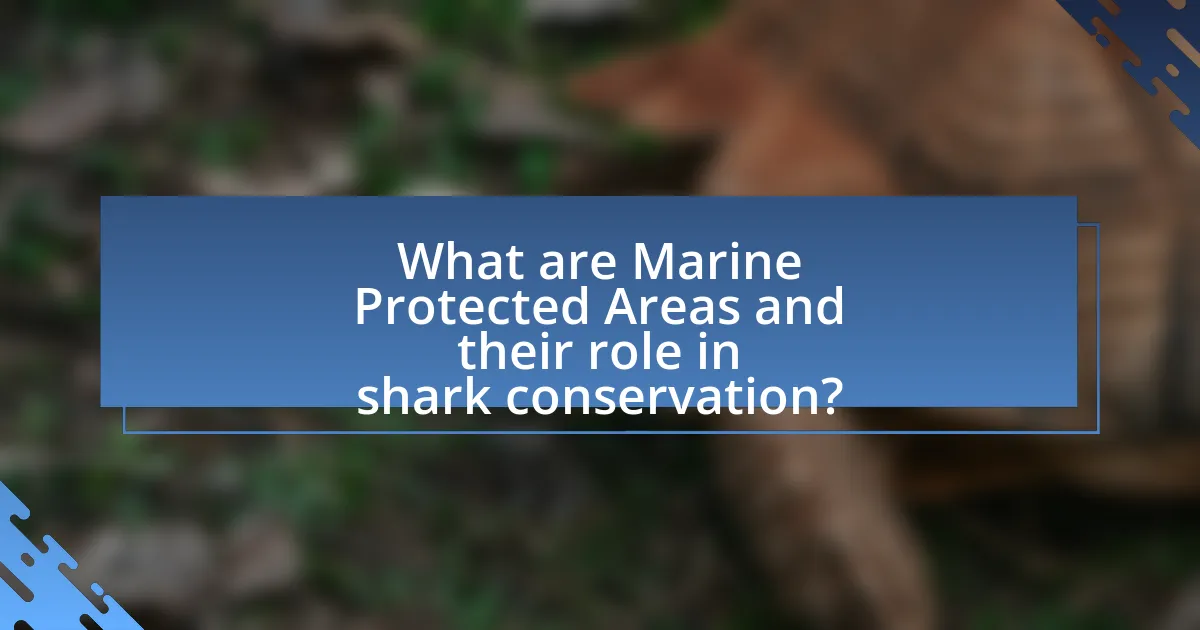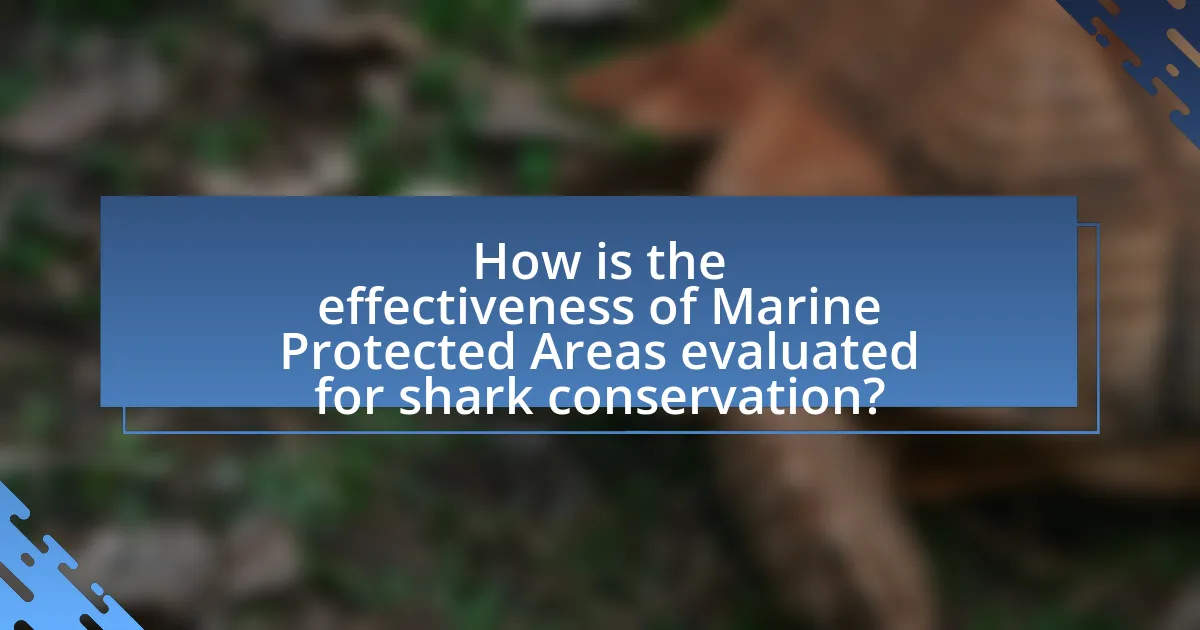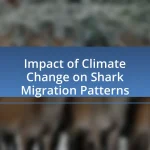Marine Protected Areas (MPAs) are designated regions in oceans and coastal waters aimed at conserving marine ecosystems and biodiversity, playing a vital role in shark conservation. This article evaluates the effectiveness of MPAs in enhancing shark populations by implementing regulations that restrict harmful activities, thereby providing safe habitats for sharks to thrive. Key metrics for assessing MPA success include population density, species diversity, and reproductive success, with evidence showing that protected areas can lead to significant increases in shark abundance. The article also discusses the ecological importance of sharks, the challenges in evaluating MPAs, and best practices for improving conservation outcomes through stakeholder engagement and ongoing research.

What are Marine Protected Areas and their role in shark conservation?
Marine Protected Areas (MPAs) are designated regions in oceans and coastal waters where human activities are regulated to conserve marine ecosystems and biodiversity. MPAs play a crucial role in shark conservation by providing safe habitats that allow shark populations to recover from overfishing and habitat degradation. Research indicates that MPAs can lead to increased shark abundance and diversity, as evidenced by a study published in the journal “Conservation Biology,” which found that shark populations in protected areas were up to three times higher than in unprotected areas. This protective measure helps maintain ecological balance and supports the overall health of marine environments, which are vital for the survival of various shark species.
How do Marine Protected Areas function to protect shark populations?
Marine Protected Areas (MPAs) function to protect shark populations by restricting fishing and other harmful activities within designated zones, thereby providing a safe habitat for sharks to thrive. These areas help to maintain healthy ecosystems, which are crucial for the survival of shark species, as they rely on abundant prey and suitable breeding grounds. Research indicates that MPAs can lead to increased shark abundance and diversity; for example, a study published in the journal “Conservation Biology” found that shark populations in protected areas can be up to three times larger than in unprotected regions. This evidence supports the effectiveness of MPAs in enhancing shark conservation efforts.
What specific regulations are implemented within Marine Protected Areas?
Marine Protected Areas (MPAs) implement specific regulations such as restrictions on fishing, prohibitions on certain types of fishing gear, and limitations on marine resource extraction. These regulations aim to conserve marine biodiversity and protect critical habitats, particularly for vulnerable species like sharks. For instance, in the United States, the National Marine Fisheries Service enforces regulations that prohibit commercial fishing in designated no-take zones within MPAs, which helps to restore shark populations by reducing fishing pressure. Additionally, many MPAs establish seasonal closures to protect spawning aggregations, further supporting shark conservation efforts.
How do these regulations impact shark behavior and population dynamics?
Regulations, such as those implemented in Marine Protected Areas (MPAs), significantly influence shark behavior and population dynamics by providing safe habitats that reduce fishing pressure. These protections allow shark populations to recover, leading to increased abundance and diversity within these areas. Studies have shown that MPAs can enhance reproductive success and juvenile survival rates, as evidenced by a 2016 study published in the journal “Conservation Biology,” which found that shark populations in protected areas were 50% larger than those in unprotected regions. Consequently, the establishment of MPAs not only stabilizes shark populations but also alters their movement patterns, as sharks tend to exhibit increased residency and reduced migratory behavior in response to the absence of fishing threats.
Why are sharks important to marine ecosystems?
Sharks are crucial to marine ecosystems as apex predators that help maintain the balance of marine life. By regulating the populations of prey species, sharks prevent overgrazing of vital habitats such as seagrasses and coral reefs, which are essential for biodiversity. Research indicates that the decline of shark populations can lead to an increase in smaller predator species, resulting in a cascade of negative effects on the ecosystem, including the depletion of herbivorous fish that graze on algae. This imbalance can ultimately harm coral reef health and reduce overall marine biodiversity, as evidenced by studies showing that areas with healthy shark populations exhibit greater ecological stability and resilience.
What ecological roles do sharks play in maintaining marine biodiversity?
Sharks play a crucial ecological role in maintaining marine biodiversity by acting as apex predators that help regulate the populations of various marine species. This predation prevents overpopulation of certain species, which can lead to imbalances in the ecosystem. For instance, studies have shown that the decline of shark populations can result in an increase in herbivorous fish, which in turn can lead to overgrazing of seagrass beds and coral reefs, ultimately diminishing habitat complexity and biodiversity. Research published in the journal “Ecology Letters” indicates that healthy shark populations contribute to the stability and resilience of marine ecosystems, underscoring their importance in conservation efforts within marine protected areas.
How does the decline of shark populations affect other marine species?
The decline of shark populations negatively impacts other marine species by disrupting the balance of marine ecosystems. Sharks are apex predators, and their reduction leads to an increase in the populations of smaller fish and invertebrates, which can result in overgrazing of seagrass and coral reefs. For instance, studies have shown that the removal of sharks can lead to a significant rise in herbivorous fish, which in turn can decimate seagrass beds, affecting species that rely on these habitats for survival. This cascading effect illustrates the critical role sharks play in maintaining the health and stability of marine environments.

How is the effectiveness of Marine Protected Areas evaluated for shark conservation?
The effectiveness of Marine Protected Areas (MPAs) for shark conservation is evaluated through various metrics, including population density, species diversity, and reproductive success of shark populations within the protected zones. Studies have shown that MPAs can lead to significant increases in shark abundance; for instance, research published in the journal “Conservation Biology” found that shark populations in MPAs increased by an average of 50% compared to unprotected areas over a five-year period. Additionally, monitoring programs assess the ecological health of these areas by examining habitat quality and the presence of key species, which further supports the evaluation of MPAs’ effectiveness in conserving shark populations.
What metrics are used to assess the success of Marine Protected Areas?
Metrics used to assess the success of Marine Protected Areas (MPAs) include biodiversity indicators, fish biomass, habitat quality, and compliance rates. Biodiversity indicators measure the variety of species present, while fish biomass assesses the abundance of fish populations, which is crucial for evaluating the health of marine ecosystems. Habitat quality metrics evaluate the condition of critical habitats, such as coral reefs and seagrass beds, which are essential for shark conservation. Compliance rates indicate the adherence to regulations within MPAs, reflecting the effectiveness of management strategies. These metrics collectively provide a comprehensive understanding of the ecological and regulatory success of MPAs in promoting shark conservation.
How do researchers measure shark population recovery within these areas?
Researchers measure shark population recovery within marine protected areas (MPAs) primarily through methods such as population surveys, tagging and tracking, and genetic analysis. Population surveys involve visual assessments and catch data to estimate shark abundance and diversity over time. Tagging and tracking allow researchers to monitor individual movements and behaviors, providing insights into population dynamics and habitat use. Genetic analysis helps in understanding population structure and connectivity among different areas. These methods collectively provide concrete evidence of recovery trends, with studies indicating that MPAs can lead to significant increases in shark populations, as seen in the 2019 research by Heupel et al., which demonstrated a 50% increase in shark abundance within protected zones compared to unprotected areas.
What indicators show the health of marine ecosystems in relation to shark conservation?
Indicators that show the health of marine ecosystems in relation to shark conservation include shark population density, biodiversity levels, and the presence of key species within the ecosystem. Shark population density reflects the abundance of sharks, which is crucial for maintaining ecological balance, as sharks are apex predators that regulate prey populations. Biodiversity levels indicate the variety of species in the ecosystem; higher biodiversity often correlates with healthier ecosystems that can support shark populations. The presence of key species, such as prey fish and other marine life, demonstrates a functioning food web, essential for sustaining shark populations. Studies have shown that areas with robust shark populations often exhibit greater overall marine biodiversity, reinforcing the interconnectedness of species within marine ecosystems.
What challenges exist in evaluating Marine Protected Areas for shark conservation?
Evaluating Marine Protected Areas (MPAs) for shark conservation faces several challenges, including data limitations, ecological variability, and enforcement issues. Data limitations arise from insufficient long-term monitoring and lack of baseline data on shark populations, making it difficult to assess the effectiveness of MPAs. Ecological variability, such as changes in habitat and prey availability, can influence shark behavior and distribution, complicating evaluations. Additionally, enforcement issues, including illegal fishing and habitat degradation, undermine the protective measures intended by MPAs, leading to challenges in accurately measuring their impact on shark conservation.
How do external factors influence the effectiveness of Marine Protected Areas?
External factors significantly influence the effectiveness of Marine Protected Areas (MPAs) by impacting their ecological integrity and management success. For instance, factors such as climate change, pollution, and fishing pressure can undermine the conservation goals of MPAs. Research indicates that rising sea temperatures and ocean acidification, driven by climate change, can alter marine ecosystems, affecting species distribution and health within MPAs. Additionally, pollution from land-based sources can degrade water quality and habitat conditions, further threatening marine biodiversity. A study published in “Marine Policy” by Edgar et al. (2014) found that MPAs are more effective when external pressures are minimized, highlighting the importance of integrated management approaches that consider surrounding environmental and human activities.
What limitations do researchers face in data collection and analysis?
Researchers face several limitations in data collection and analysis when evaluating the effectiveness of Marine Protected Areas (MPAs) for shark conservation. These limitations include restricted access to certain marine areas, which can hinder comprehensive data gathering, and the variability in shark populations that complicates consistent monitoring. Additionally, researchers often encounter challenges related to the availability and reliability of data, as many regions lack long-term datasets necessary for robust analysis. For instance, a study published in “Conservation Biology” by McCauley et al. (2015) highlights that inconsistent reporting and data gaps can lead to skewed results in assessing MPA effectiveness. Furthermore, logistical constraints, such as funding and resource limitations, can impede the scope and scale of research efforts, ultimately affecting the quality of findings.

What are the outcomes of Marine Protected Areas on shark populations?
Marine Protected Areas (MPAs) significantly enhance shark populations by providing safe habitats that reduce human impacts such as fishing and habitat destruction. Research indicates that MPAs can lead to increased shark abundance and diversity, as evidenced by a study published in the journal “Conservation Biology,” which found that shark populations in protected areas were up to three times higher than in unprotected regions. Additionally, MPAs contribute to the recovery of overfished shark species, promoting ecological balance and resilience in marine ecosystems.
How have specific Marine Protected Areas impacted shark conservation efforts?
Specific Marine Protected Areas (MPAs) have significantly enhanced shark conservation efforts by providing safe habitats that reduce human impacts such as fishing and habitat degradation. Research indicates that MPAs can lead to increased shark populations and biodiversity within their boundaries. For instance, a study published in the journal “Marine Ecology Progress Series” found that in the Bahamas, the establishment of no-take MPAs resulted in a 200% increase in shark abundance over a five-year period. Additionally, MPAs help in the recovery of overfished shark species by allowing them to reproduce and grow without the pressures of fishing. This evidence underscores the critical role that well-managed MPAs play in the conservation of shark populations globally.
What case studies demonstrate successful shark population recovery?
Case studies demonstrating successful shark population recovery include the recovery of the grey reef shark in the Palau National Marine Sanctuary and the rebound of the Caribbean reef shark in the Bahamas. In Palau, the establishment of a large marine protected area in 2009 led to a significant increase in grey reef shark populations, with surveys indicating a rise from 1.5 sharks per 100 meters to over 10 sharks per 100 meters within five years. Similarly, in the Bahamas, the implementation of a no-take zone in 1993 resulted in a doubling of Caribbean reef shark populations over a decade, showcasing the effectiveness of marine protected areas in facilitating shark recovery.
How do different Marine Protected Area designs affect conservation outcomes?
Different Marine Protected Area (MPA) designs significantly influence conservation outcomes by varying in size, location, and management strategies. Larger MPAs often provide more effective habitat protection and allow for greater biodiversity recovery, as evidenced by studies showing that well-designed MPAs can lead to a 20-50% increase in fish biomass within five years. Additionally, MPAs located in critical habitats, such as breeding or nursery areas, yield better conservation results for species like sharks, which rely on these environments for survival. Research published in “Conservation Biology” by Edgar et al. (2014) indicates that effective management practices, including enforcement and community involvement, further enhance the success of MPAs in achieving conservation goals.
What best practices can enhance the effectiveness of Marine Protected Areas for sharks?
Implementing no-take zones within Marine Protected Areas (MPAs) significantly enhances their effectiveness for shark conservation. No-take zones restrict fishing and other extractive activities, allowing shark populations to recover and thrive. Research indicates that MPAs with no-take zones can lead to a 50% increase in shark biomass within just a few years, as demonstrated in studies conducted in the Bahamas and the Great Barrier Reef. Additionally, effective enforcement of regulations within MPAs is crucial; areas with strong enforcement mechanisms show higher compliance rates and better conservation outcomes. Furthermore, incorporating local community engagement in the management of MPAs fosters stewardship and increases the likelihood of successful conservation efforts. Studies have shown that when local communities are involved, compliance with conservation measures improves, leading to healthier shark populations.
How can stakeholder engagement improve conservation strategies?
Stakeholder engagement can significantly improve conservation strategies by fostering collaboration and ensuring that diverse perspectives are considered in decision-making processes. Engaging local communities, fishermen, scientists, and policymakers allows for the integration of traditional knowledge and scientific data, which enhances the effectiveness of conservation measures. For instance, a study published in the journal “Conservation Biology” found that marine protected areas (MPAs) that involved local stakeholders in their design and management were more successful in achieving biodiversity goals compared to those that did not. This collaborative approach not only increases compliance with conservation regulations but also builds trust and ownership among stakeholders, leading to more sustainable practices and better outcomes for shark conservation within MPAs.
What role does ongoing research play in adapting Marine Protected Areas for better outcomes?
Ongoing research plays a critical role in adapting Marine Protected Areas (MPAs) for better outcomes by providing data-driven insights that inform management strategies. This research helps identify the ecological needs of shark populations, assess the effectiveness of current protections, and adapt regulations based on changing environmental conditions. For instance, studies have shown that continuous monitoring of shark populations within MPAs can reveal trends in species recovery and habitat use, allowing for timely adjustments to conservation measures. Additionally, research initiatives, such as those conducted by the Marine Conservation Society, demonstrate that incorporating scientific findings into policy can enhance the resilience of marine ecosystems, ultimately leading to improved biodiversity and sustainable fisheries.
What practical steps can be taken to support shark conservation through Marine Protected Areas?
To support shark conservation through Marine Protected Areas (MPAs), implementing strict regulations on fishing practices within these zones is essential. These regulations can include prohibiting shark fishing, establishing catch limits, and enforcing seasonal closures to protect breeding populations. Evidence shows that MPAs with such restrictions can lead to increased shark populations; for instance, a study published in the journal “Marine Ecology Progress Series” found that MPAs in the Caribbean resulted in a 50% increase in shark abundance over five years. Additionally, enhancing habitat protection by preserving critical areas such as nurseries and feeding grounds within MPAs is crucial, as these habitats are vital for the life cycles of many shark species. Furthermore, engaging local communities in conservation efforts through education and sustainable tourism initiatives can foster support for MPAs, as demonstrated by successful programs in places like the Bahamas, where local stakeholders benefit from shark tourism.


